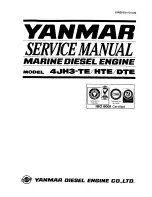
Teledyne Continental Motors, Inc.
TM
Maintenance
Inspections
IOF-240 Series Engine Maintenance Manual
7-49
31 August 2007
Change 1
6.
Check the integrity of the forward crankcase bearing support and adjacent structure.
7.
Reassemble the engine as directed in the Engine Assembly chapter in the Overhaul
Manual (OH-22).
8.
Perform the aircraft inspection as specified in the aircraft manufacturer’s instructions.
7-4.3. Hydraulic Lock
Hydraulic lock is a condition where fluid accumulates in the Induction System or the
cylinder assembly. The liquid restricts the piston from traveling during the compression
stroke. Damage to the engine occurs when the other cylinders fire which forces the piston
in the fluid filled cylinder through the compression stroke. Damage to an engine from
hydraulic lock can be extensive due to the high stresses generated. These stresses can
adversely affect connecting rods, pistons, cylinder assemblies, piston pins, the crankcase,
and the crankshaft.
Hydraulic lock may occur because of any of the following:
•
Improper maintenance of the cylinder fuel drain lines
•
Improper starting procedures
•
Failure to properly remove preservative oil from an engine that had been in storage
WARNING
Do not operate the engine if hydraulic lock is suspected.
Inspect the engine for hydraulic lock as directed below.
Procedure
1.
Remove all cylinders and connecting rods in accordance with instructions in the
Overhaul Repair and Replacement Procedures chapter in this manual.
2.
If all rods meet the TCM service limits, re-assemble the engine in accordance with
instructions in the Engine Assembly chapter in the Overhaul Manual (OH-22).
3.
If any connecting rod does not meet acceptance criteria, remove and disassemble the
engine to allow inspection of the crankcase and crankshaft in accordance with
instructions in the Overhaul Manual (OH-22). Replace any part that does not meet the
inspection criteria listed in the Overhaul Inspection Procedures. Replace each non-
conforming connecting rod, associated piston, piston pin, and cylinder assembly.
NOTE: Any parts that require replacement must be destroyed to
prevent future installation.
4.
Reassemble and test the engine as directed in the Engine Assembly and Post-overhaul
Testing chapters in the Overhaul Manual (OH-22).
















































